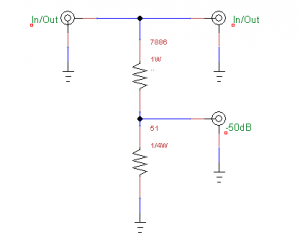I noticed something interesting when I was testing my Raspberry Pi WSPR transmitter: just how little signal is needed to receive WSPR! I was using a FUNcube Dongle Pro+ receiver to monitor my transmitted signal. This neat SDR (Software Defined Radio) covers from 150 KHz to 1.9 GHz (with a gap between 240 and 420 MHz). It has some nice built-in filters and performs well.

The FUNcube was feeding the WSPR WSJT-X program (WSJT-X), and connected to the RPi WSPR transmitter / antenna with a -50dB tap/attenuator:

I made this attenuator a while back when I was testing my 100-Watt ham HF transceiver. This tap lets me connect the rig to a dummy load (or an antenna) and siphons off a low-level signal that I can connect to my spectrum analyzer or other measuring equipment. With a 100W through-signal, the signal at the tap is 1mW (that’s -50dB). With that 100W signal the 7886 Ohm resistor dissipates about 0.6W, so I paralleled four 1/4W resistors (3300 || 3300 || 3300 || 2700 Ohms) to get close to the calculated value. The thing works well enough at HF frequencies, but I wouldn’t trust the accuracy at VHF.
Anyway, with this tap I could monitor my on-the-air 20-meter WSPR transmissions. What really surprised me was when I started receiving WSPR signals from the K6SRO WSPR beacon through that 50dB attenuator! K6SRO transmits at 5W at a distance of over 1,000 kilometers from my receiver. The received signal-to-noise ratio was -17dB, which is at least 12dB better than needed for WSPR decoding.
I suppose this reminds us that on the HF bands the atmospheric background noise is usually the dominant factor, and when it comes to receiving our antennas are less critical that we might imagine.